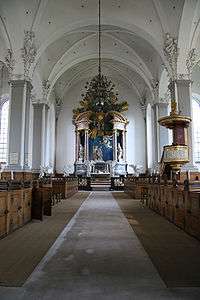Lambert van Haven
Lambert van Haven (16 April 1630 - 9 May 1695) was a Danish architect, master builder and painter. He was born in Bergen, the son of the artist Solomon van Haven who had already succeeded in winning the favour of the Danish monarchy.[1]
Lambert van Haven | |
|---|---|
 Lambert van Haven painted by his brother Michael van Haven | |
| Born | 16 April 1630 |
| Died | 9 May 1695 (aged 65) Copenhagen, Denmark |
| Nationality | Danish |
| Occupation | Architect |
Starting in 1653, he spent some 16 years travelling in Italy, France and the Netherlands where he studied Baroque painting and architecture.[2]
Under Christian V, he was appointed Denmark's first official General Building Master in 1671 with overall responsibility for executing the king's architectural wishes.[3] He died in Copenhagen.
Principal works
Church of Our Saviour

Van Haven is remembered above all for his architecture, especially for the enormous Church of Our Saviour, Copenhagen built in the Dutch Baroque style in the form of a Greek cross with Tuscan pilasters rising to the top of the facade.[4]
Nørreport
Commissioned by Christian V, van Haven also designed the imposing new Nørreport city gate (1671) after the original gate had fallen into disrepair.[5] Until it was dismantled in 1857, it was considered to be the tallest and finest of Copenhagen's city gates with fine sandstone ornamentation.
Frederiksborg interiors
Inspired by the Italian and French Baroque style, especially Bernini's, he designed the interiors of Frederiksborg Palace which had been damaged by fire. The Audience Chamber, glorifying Christian V, is considered a masterpiece.[6]
Other contributions
He probably also participated in the design of Charlottenborg Palace[7] and in that of Niels Juel's Mansion on Kongens Nytorv, now the French Embassy.[8] He was also involved in designing a residential palace on Slotsholmen but this was never realised.
See also
References
- Solomon van Haven. From Art Encyclopedia. Retrieved 18 December 2009.
- v. Haven, Lambert. From Dansk biografisk Lexikon. In Danish. Retrieved 18 December 2009.
- Barok from DAC.dk. Archived 2012-02-23 at the Wayback Machine In Danish. Retrieved 18 December 2009.
- Vor Frelsers Kirke. Retrieved 18 December 2009.
- Nørreport, København. From Byhistorie.dk. Archived 2007-09-27 at the Wayback Machine Retrieved 18 December 2009.
- Frederiksborg Slot. From Det Nationalhistoriske Museum. In Danish. Retrieved 18 December 2009.
- Lambert van Haven. From Den store Danske. Retrieved 17 December 2009.
- Thotts Palæ. København. Kulturhistoriek opslagsbog med turforslag by Jens Fleischer. In Danish. Retrieved 18 December 2009.